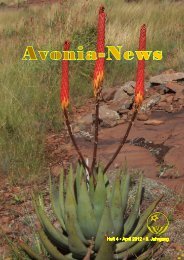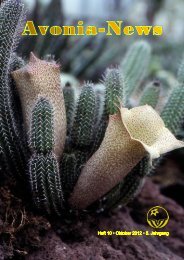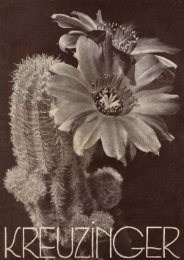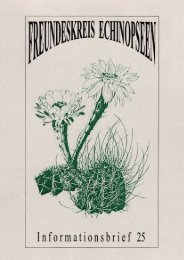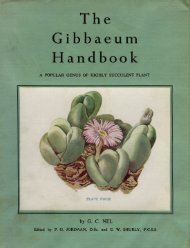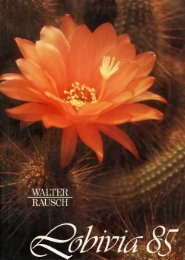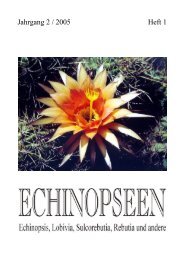Lithops - Au Cactus Francophone
Lithops - Au Cactus Francophone
Lithops - Au Cactus Francophone
Create successful ePaper yourself
Turn your PDF publications into a flip-book with our unique Google optimized e-Paper software.
structure referred to above, is more or less circular or semilunar in shape and<br />
its surface varies from apparently opaque to transparent.<br />
Walter (4) determined the amount of moisture taken up and lost by<br />
<strong>Lithops</strong> salicola. He found that in one case a large plant (weighing 11.50<br />
gm.) lost per diem when fully exposed to the sun scarcely 0.1 gm. in weight.<br />
Another plant (weighing 4.395 gm.) lost in 15 days scarcely 0.2 gm. Walter<br />
also determined the amount of water taken up by the roots of these plants.<br />
By placing a plant so that the roots were immersed in water, he found that<br />
a plant weighing 23.95 gm. had taken up 3.3 gm. of water in 15 days. By<br />
making a small cut at the base of the plant and putting it in water, this plant<br />
had absorbed 7 gm, of water in 24 hours. It thus appears that the whole<br />
surface of the plant, including the root system, is practically impervious to<br />
water. Walter also found that a plant gained scarcely 0.1 gm. per day when<br />
fully submerged in water. Absorption of water takes place apparently through<br />
the newly developed roots and not through the old roots.<br />
This protection against the loss of water is of very great advantage,<br />
because most of the species of this genus grow in the most arid parts of<br />
the country, where the relative humidity of the atmosphere is very low, and<br />
consequently plants would lose all their moisture if not protected against such<br />
loss. Apart from the low humidity content, these areas very frequently have<br />
rainless periods of 12–20 months or even longer.<br />
Green plants, as is well known, are dependent on light for the manu<br />
facture of their food. In this genus the plant is buried in the soil and if the<br />
exposed top surface were green the light could not penetrate very deeply into<br />
the tissues and thus the greening of the underlying cells would be prevented.<br />
If the chlorophyll were confined to the top surface of the leaf this would be<br />
the same as a reduction in leaf surface, and consequently the amount of solar<br />
energy available for the manufacture of the food would be very small in<br />
deed. This difficulty could be overcome by increasing the top surface, but that<br />
would be attended with the additional dangers of desiccation and heating of<br />
the body of the plant, especially as these plants are embedded in a soil which<br />
is also exposed to the full rays of the sun. In species of <strong>Lithops</strong> an interesting<br />
way out of this difficulty has been found. The chlorophyll containing cells line<br />
the inner surface of the mantle and thus lie for the most part below the soil<br />
level, and all the light which reaches them must come from above through<br />
the window like top (Fig. 3). In some species the top surface is transparent<br />
(L. optica, L. olivacea, L. marmorata), in others there are a number of mini<br />
ature windows (L. fulviceps), i.e. small transparent areas with opaque tissue<br />
between, while in other species (L. Meyeri) the top surface, though opaque,<br />
yet allows sufficient light to pass through. Schanderl (2) has found that in the<br />
case of Fenestraria rhopalophylla, where the window resembles that of L. optica<br />
and L. olivacea, 90–91.5 per cent. of the incident light passes through, and at<br />
a depth of 17, mm. only diffuse light is found. In other words the transparent<br />
window lets through a very considerable quantity of light.<br />
6




